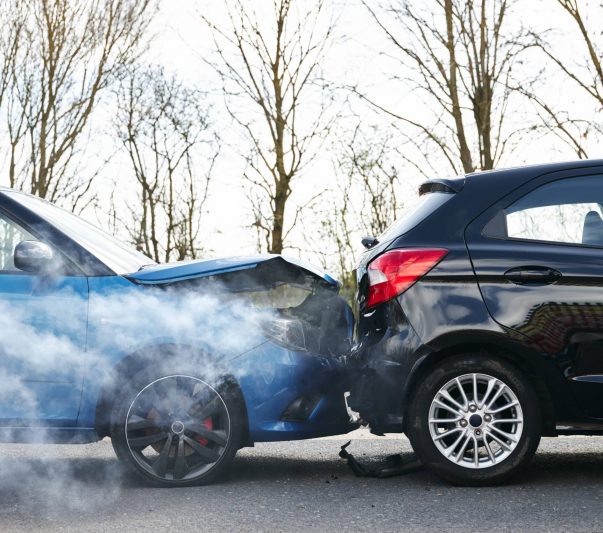No. “Liability” refers to damage you cause to someone else. If you cause an accident, you might be liable for the damages suffered by others involved in the crash, including property damage and medical expenses. If the person who hit your car sued you for these damages and you were found to be all or mostly at fault, your liability insurance should pay their claim. It will not pay for your own car repairs or medical bills.
However, some options allow you to cover your expenses in an accident where you were primarily responsible (or where you simply don’t have enough evidence to prove the other driver was at fault). Collision insurance will pay for car repairs/property damage in an accident, regardless of who was at fault. Similarly, MedPay coverage will cover any medical expenses your health insurance doesn’t, regardless of fault.
But not everyone has collision and MedPay on their auto insurance policy. Unlike liability insurance, these add-ons are not required in Colorado or Wyoming. To save money, some people only buy the minimum required insurance, which is $25,000 per person for bodily injury or death, with a total of $50,000 per accident. Colorado also requires $15,000 in property damage liability, and Wyoming mandates $20,000. Uninsured/Underinsured motorist, collision, and MedPay are optional, but if you’re in an accident that isn’t covered by another party’s car insurance, you might wish you’d purchased them.
Key Takeaways
- Liability insurance covers damages to others if you’re at fault in an accident, but it won’t cover your own vehicle repairs or medical bills. Optional coverage like collision or MedPay can provide additional protection, especially if you’re at fault or the other driver is uninsured.
- Under Colorado and Wyoming law, both parties may share responsibility for an accident, impacting the amount of compensation you can receive. If you’re found partially at fault, your damages may be reduced according to the percentage of responsibility assigned.
- If you’re facing significant liability in a car accident, having the right insurance and a skilled car accident lawyer can make a difference.
What to Do if You Have Liability Insurance and You Hit Someone?
Check yourself and your passengers for injuries, call 911 to report the accident, request an ambulance if needed, and check on the people in the other car. Offer reasonable assistance to anyone who is injured and stay with them until help arrives. When discussing the accident and giving a statement to the police, do not admit fault, whether or not you think you were at fault. It isn’t always clear who caused the accident, and in many crashes, both drivers have some responsibility.
You should exchange contact and insurance information with the other driver, and the responding law enforcement officer will also need this information for their report. Providing your insurance information is not an admission of guilt; it simply means you comply with the law. When questioned by the police, you should answer honestly, but don’t speculate about fault or volunteer information they didn’t ask for.
Understanding Modified Comparative Negligence in Car Accident Cases
Additionally, culpability can be shared under Wyoming and Colorado law. Both states use modified comparative negligence statutes for torts like car accident cases. These laws take into consideration the fact that many accidents are more than one party’s fault. One driver might be speeding while the other driver was looking at their phone, for example. Both drivers made mistakes, but who was mostly at fault for the accident?
Ultimately, the insurance companies will work out responsibility, and the driver who was more at fault (more than 50 percent) will be deemed liable. As a result, their liability insurance will pay for the other driver’s damages, such as car repairs and medical bills. But there is one more stipulation of modified comparative negligence: Any percentage of responsibility attributed to the injured party is deducted from the final award for damages.
An example would be if you were going a little beyond the speed limit, but another car turned out of a parking lot right into your path. Could you have stopped in time if you’d driven ten miles an hour slower? Probably not, because the other car didn’t leave you much time to react. Still, the increased speed might have made the damage to both cars a little worse. After negotiations, the insurance companies decide the driver who didn’t look before turning was 90 percent at fault, and you were 10 percent at fault. So if you had $5,000 in damages, you would receive $4,500.
Having the help of an experienced car accident attorney can benefit you in the negotiation process. We always fight to tell our client’s side of the story and present as much evidence as possible that they had little to no responsibility for the accident. In many cases, this results in a lower percentage of fault and a larger settlement for the client.
Car accidents can cause life-altering injuries and leave you with significant financial burdens. If you’ve been hurt due to someone else’s negligence, you may have the right to compensation. Our car accident lawyers are here to help you get justice.
What If it Turns Out You Were at Fault?
The good news is that this is what your liability insurance is for. Your insurance company should pay for the other party’s damages up to the policy limit. The bad news is that in cases with high-dollar damages, the minimum insurance may not cover all the other party’s damages, and they could sue you for the difference. For example, if you happen to hit someone who is driving a very expensive car that receives a large amount of damage, $15,000 or $20,000 in property damage coverage may still leave you with some exposure. For that reason, we strongly recommend buying more than the minimum required insurance if you can afford it.
Even in situations where you are primarily at fault, a lawyer may be able to help reduce your liability by showing that the other driver also contributed to the crash.
Your own damages would be covered up to the limit of your MedPay or Collision coverage if you opted to buy these. (If you don’t have them, consider adding them to your policy.)
Talk to a Car Accident Lawyer Today
Attorney Sean Olson founded the Olson Personal Injury Lawyers in 2012 to assist injured people in getting the help and compensation they deserve. He listens to each client’s story and is very responsive. When he takes your case, he aims to help you navigate the complex system of recovering your damages through insurance coverage.
If you need help with your car accident claim, our attorneys are here to help. Contact the Olson Personal Injury Lawyers for a free consultation. We’ll listen to your story, study the details of your case, answer your questions, and explain your options for pursuing a claim.






